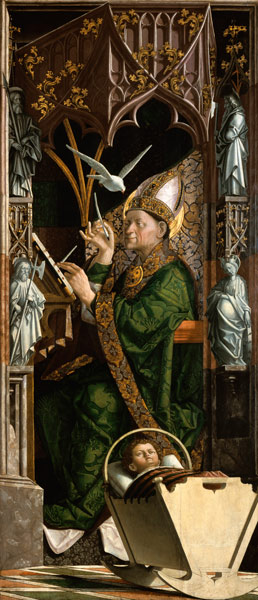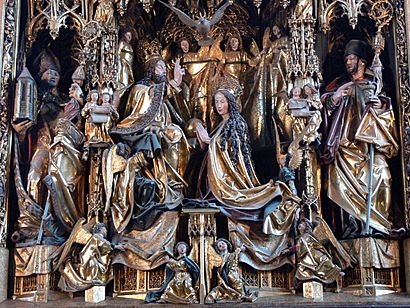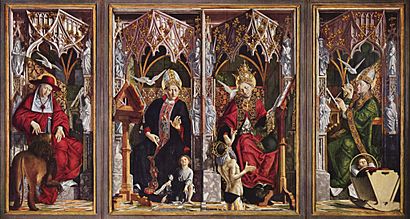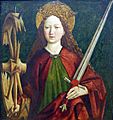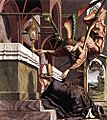Michael Pacher facts for kids
Michael Pacher (around 1435 – August 1498) was a talented painter and sculptor from South Tyrol. He worked in the late 1400s. Pacher was one of the first artists to bring the ideas of Renaissance painting to Germany. He was skilled in many areas, creating amazing art from wood and stone. He also painted huge altarpieces, which are large artworks placed behind altars in churches.
Pacher's most famous work is the St. Wolfgang Altarpiece (1471–1481). Many people consider it one of the most amazing carved and painted altar shrines in Europe. It shows scenes from the life of Jesus and the Virgin Mary. Another important work is the Altarpiece of the Church Fathers, made in 1483. This piece combined painting and sculpture in a very special way.
Pacher was mostly influenced by artists from northern Italy, like Andrea Mantegna. However, you can also see German influences in his art, especially in his wood sculptures. Pacher mixed Italian Renaissance styles with Northern Gothic realism. This blend helped him create his own unique painting style.
Contents
Early Life and Training
Michael Pacher was born around 1435 near Brixen, in the County of Tyrol. This area is in the southern part of the Alps. We don't know much about how he learned his skills. His first known artwork was an altarpiece from 1465, but it is now lost. Pacher traveled to Padua in northern Italy. There, he was greatly inspired by the modern fresco paintings of Andrea Mantegna. Mantegna was famous for his use of perspective, which is creating the illusion of depth on a flat surface. His unique way of showing space was very important for Pacher's own style. Because of these Italian influences, Pacher's art was different from most German artists of his time.
By 1467, Pacher was a well-known artist and sculptor in Bruneck. This town is about 25 miles east of Brixen. He had a workshop there where he made altarpieces, and his old house still stands today. His talent in wood carving and painting helped him get many jobs creating German-style altars. These altars usually had carved figures in the middle, fancy Gothic carvings on top, a base where the altar stood, and painted scenes on side panels. During the 1470s, Pacher spent a lot of time in Neustift, near Brixen, mainly painting frescoes. In 1484, the Franciscan Order in Salzburg asked him to create another altarpiece. Parts of this work still exist. Sadly, many of Pacher's artworks have been lost or badly damaged over time. His most important surviving pieces are the St. Wolfgang Altarpiece and the Altarpiece of the Church Fathers.
The St. Wolfgang Altarpiece
The St. Wolfgang Altarpiece is probably Pacher's most famous work. It is still in its original church in St. Wolfgang im Salzkammergut, Austria. This altarpiece is a polyptych, which means it's a painting or carving made of several panels. It has two sets of movable wings. This allows for three different displays, depending on the occasion: one for everyday, one for Sundays, and one for special holy days.
Abbot Benedict Eck of Mondsee ordered this huge altarpiece in 1471, and it was finished in 1481. When the inner panels are open, you can see the carved and painted gold centerpiece. This part shows the Coronation of the Virgin, with a beautiful kneeling Madonna and large Gothic figures. The outer panels, which are painted, show four scenes from the life of Saint Wolfgang. Wolfgang was a bishop known for his strong beliefs and his skills as a leader.
An elaborate wooden structure sits on top of the entire altarpiece, holding a carving of the Crucifixion. In the main part, Christ is seated on a throne, blessing Mary as he crowns her Queen of Heaven. Following German Gothic art traditions, angels fly around, and John the Evangelist watches. The inside of the second panels, on both sides of the carved center, are painted with scenes from the life of the Virgin.
Some experts believe that Michael Pacher was not the only artist who worked on this very large altarpiece. His brother, Friedrich Pacher, might have painted the outer parts that show scenes from Saint Wolfgang's life. These parts are only seen when the altarpiece is closed. However, it seems that Michael Pacher himself completed all the inner paintings.
Altarpiece of the Church Fathers
The Altarpiece of the Church Fathers was made in 1483 for Neustift Monastery. It is probably Pacher's second most famous work. What makes this artwork special is how Pacher blurred the lines between painting and sculpture.
The Altarpiece of the Church Fathers is divided into four sections. Each section shows one of the four Great Doctors of the Western Church: Ambrose, Augustine, Jerome, and Pope Gregory I. On the far left is Saint Jerome, dressed in his cardinal's clothes. Jerome is famous for a story where he pulled a thorn from a lion's paw, and indeed, a lion is with him in Pacher's work. To his right is the panel of Augustine, shown with a child from a legend about him. The legend says Augustine saw a child scooping water with a spoon at the beach. When Augustine asked what he was doing, the child said his task was as pointless as Augustine trying to understand the Holy Trinity with his mind.
To Augustine's right is Pope Gregory I, shown with Emperor Trajan. Gregory I is known for praying to bring dead Trajan's soul back to life and baptizing it to save him from purgatory. On the far right is Archbishop Ambrose, shown with a baby in a cradle. This likely represents a legend about his life: when Ambrose was a baby, a swarm of bees covered his face and left a drop of honey. Ambrose’s father saw this as a sign that Ambrose would become a very eloquent speaker. Another idea is that the child in the cradle was the one who asked Ambrose to become bishop of Milan. Each of the four Church Fathers is shown with a dove, which symbolizes the presence of the Holy Spirit and represents their holiness.
Death
Michael Pacher passed away in 1498, possibly in Salzburg, Austria.
Works by Michael Pacher
Here are some of the artworks believed to be by Michael Pacher:
- St. Thomas Becket Altar, Johanneum, Graz, 1465
- Statue of the Virgin, Parish Church, St. Lorenzen im Pustertal, around 1465
- Wing panels, Parish Church, St. Lorenzen im Pustertal, around 1465
- Frescoes on the Vaulting, Sacristy, Neustift Abbey, Italy, 1469–70
- Tabernacle, Welsberg-Taisten, Italy, around 1470
- Flight into Egypt, Kunstmuseum Basel, around 1470
- St. Wolfgang Altarpiece, Parish Church, St. Wolfgang im Salzkammergut, Austria, 1471–81
- Altar of the Coronation of the Virgin, Old Parish Church of Gries, Bolzano, Italy, 1475
- Statue of the Virgin and Child, Old Parish Church of Gries, Bolzano, Italy
- Frescoes Above the South Door, Collegiate Church, Innichen, Italy, around 1480
- Altarpiece of the Church Fathers, Alte Pinakothek, Munich, 1480–83
- Statue of Saint Lawrence, Tyrolean State Museum, Innsbruck, around 1480–90
- Statue of Saint Michael, Bavarian National Museum, Munich, 1482–84
- Crucifix, National Museum, Warsaw, around 1490
- Four Panels with Heads of Saints, Wilten Abbey, Innsbruck
- High Altar, Franciscan Church, Salzburg, around 1495
- Statue of the Virgin, Franciscan Church, Salzburg
- Betrothal of the Virgin and the Flagellation of Christ, Österreichische Galerie Belvedere, Vienna
- Joseph Lowered into the Well, Österreichische Galerie Belvedere, Vienna
- Head of Saint Anne, Private Collection, Vienna
Gallery
See also
 In Spanish: Michael Pacher para niños
In Spanish: Michael Pacher para niños


